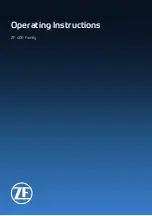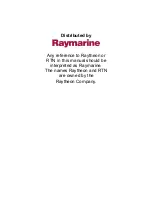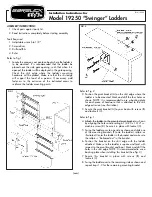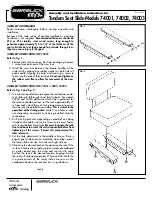
28
DL251 Audio System I/O
MUSIC Group IP Limited
DL251/DL252 Front Panel
3. Front Panel
1
The
psu
panel monitors the two voltage supplies.
There are five yellow LEDs per voltage supply, and each LED
represents a voltage rail. An LED will illuminate when its
respective voltage rail is active.
2
The
ID select
panel lets you select the ID number of
the unit. This is a unique number that is recognised by the
system and distinguishes it from any other similar unit(s) in the
network. One of the four green LEDs will be illuminated to
indicate the currently selected ID.
3
This
control mode
panel lets you select the control
mode of the unit. Use this panel’s pushbutton to select
mode
1
if the unit is connected to a console or
mode 2
if the unit is
used in a snake configuration. Either of the two green LEDs
will illuminate to show which control mode is selected.
4
The
clock
panel lets you select the synchronisation
source of the unit. Use this panel’s pushbutton to select the
internal clock of the unit (
int
) or an external AES50 source
(
ext
). The external source is the clock of the connected device
(usually a Midas digital console) whose signal is transmitted
via the AES50 audio connector. Either of the two green LEDs
will illuminate to show which clock source is selected.
5
The
sample rate
panel has a two green LEDs, which
indicate the currently selected sample rate (96kHz or 48kHz).
6
The
Ethernet control
panel has a single green LED,
which has three states of illumination: flashing = active; on =
connected; and off = not connected.
7
The
AES50 audio
panel shows the health status of the
communications of the AES50 connections. If the green
ok
LED is illuminated, communication is good. However, if the
red
error
LED is illuminated, there is a problem on that
connection.
8
There are four air intakes for fan cooling.
Do not
obstruct.
9
There are four cut-outs for rack mounting fixings.
3. Panel frontal
1
El panel
psu
monitoriza las dos fuentes de
alimentación. Hay cinco pilotos LED amarillos por fuente de
alimentación y cada uno de ellos representa un raíl de voltaje.
Cada piloto se iluminará cuando su respectivo raíl de voltaje
esté activo.
2
El panel
ID select
le permite elegir un número de ID
(identificación) para la unidad. Este es un número único que
será reconocido por todo el sistema y que distinguirá a esta de
cualquier otra unidad(es) similar que haya en la red. Uno de
los cuatro pilotos verde se iluminará para indicarle el ID
elegido.
3
Este panel
control mode
le permite elegir el modo de
control de la unidad. Use el botón de pulsación de este panel
para elegir el modo 1 si la unidad está conectada a una mesa
de mezclas o el modo 2 si la unidad es usada en una
configuración con manguera. Uno de los dos pilotos verdes se
iluminará para indicarle el modo de control que ha
seleccionado.
4
El panel
clock
le permite elegir la fuente de
sincronización de la unidad. Utilice el botón de este panel para
elegir el reloj interno de la unidad (
int
) o una fuente AES50
externa (
ext
). La fuente externa es la señal de reloj del
dispositivo conectado (por lo general un Midas digital de la
consola) cuya señal es pasada a través del conector de audio
AES50. Uno de los dos pilotos verdes se iluminará para
indicarle la fuente de reloj elegida.
5
El panel
sample rate
tiene dos pilotos verdes que le
indican la frecuencia de muestreo activa en ese momento (96
ó 48 kHz).
6
El panel
Ethernet control
solo tiene un piloto verde
con tres posibles indicaciones: parpadeando = activo;
encendido = conectado y apagado = no conectado.
7
El panel
AES50 audio
le muestra el estado de salud de
las comunicaciones de las conexiones AES50. Si se ilumina el
piloto verde
ok,
la comunicación será correcta. Por contra, si
se ilumina el piloto rojo
error
es que existirá un problema en
esa conexión.
8
La unidad dispone de cuatro tomas de aire que usan
los ventiladores de refrigeración.
No las obstruya.
9
La unidad tiene cuatro muescas para su fijación en un
bastidor rack.
1
2
3
4
5
6
7
8
7
6
5
4
3
2
9
1
EN
ES
Summary of Contents for DL251
Page 2: ......
















































